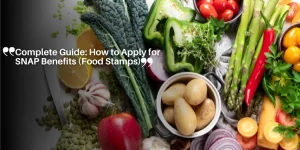SNAP Benefits Explained: A Complete Guide to America’s Largest Food Assistance Program
Overview of the Supplemental Nutrition Assistance Program (SNAP) and its Role in American Society
The Supplemental Nutrition Assistance Program (SNAP), managed by the USDA’s Food and Nutrition Service, provides food-purchasing assistance to low-income Americans.
Originally known as the Food Stamp Program, SNAP is the largest federal nutrition assistance program in the U.S. and is vital in ensuring that millions of individuals and families, including children, the elderly, and persons with disabilities, have access to nutritious food.
By providing electronic benefits that can be used to buy food at authorized retailers, SNAP Plays an essential part in the social support system, reducing food insecurity and supporting overall public health.

Transition from Food Stamp Program to SNAP and Key Program Objectives
The Food Stamp Program, launched during the Great Depression, initially aimed to alleviate hunger and stimulate economic activity by providing food-purchasing aid to impoverished Americans.
The initiative utilized paper-stamped coupons until the late 1990s when the system transitioned to Electronic Benefit Transfer (EBT) cards for improved efficiency and reduced stigma.
In 2008, the program was rebranded to SNAP to emphasize its focus on nutrition rather than just food provisioning.
Administrative Goals and Context
| 🎯 Goal | Before | After (Impact) |
|---|---|---|
| 🏛️ Government Restructuring | Large, centralized federal operations | Push for leaner, decentralized federal agencies |
| 🎓 Educational Outcomes | Federal oversight and consistency in standards | State-level innovation with potential for inconsistency |
| 💼 State Responsibilities | Federal support for schools with challenges | States taking on new roles, but facing capacity concerns |
| 👩🏫 Teacher Shortages | Adequate teacher supply and support | Increased shortages and educator burnout impacting education |
Basic Overview of How SNAP Helps Low-Income Individuals and Families Maintain Adequate Nutrition 🥕🍎
SNAP benefits are distributed monthly via EBT cards, allowing eligible individuals and families to purchase approved food items from participating retailers.
This benefit system supports access to balanced diets by enabling households to buy nutritious foods like fruits, vegetables, dairy products, proteins, and grains 🥗.
Special provisions exist to assist vulnerable populations, ensuring that everyone, regardless of their financial situation, can access essential nutrition.
As one of the cornerstones of America’s social safety net, SNAP improves health outcomes, reduces food insecurity, and promotes economic stability across communities 💪.
This systemic support is instrumental in safeguarding the well-being of millions of Americans. 🇺🇸
SNAP Eligibility Requirements 📑
General Income and Resource Requirements 💰
To qualify for SNAP benefits, households must first meet specific income and resource criteria. Generally, applicants must fall below both the Gross and net income thresholds, which are determined by the Federal Poverty Line (FPL).
Gross income refers to the total, non-exempt income before deductions. Net income is the total income minus any permitted deductions, such as housing costs, child support payments, and dependent care 🏡.
Most families must have a gross monthly income at or below 130% of the FPL and a net income at or below 100% of the FPL.
Additionally, household resources, like bank accounts, should not exceed $2,500, or $3,750 if one or more members are disabled or 60 years old or older.
Special Considerations for Immigrants, Elderly Persons, and Persons with Disabilities 🌍👵👨🦽
Immigrants 🌎
Immigrants have unique eligibility criteria under SNAP.
Most lawfully present immigrants must have lived in the U.S. for at least five years to qualify, although there are exceptions.
For instance, immigrants receiving disability-related assistance or benefits, and children under 18 are not subject to the five-year waiting period.
Specific non-citizens, like those granted entry for humanitarian purposes, may also be eligible. 🤝
Elderly Persons and Persons with Disabilities 👵🧑🦽
SNAP provides several considerations for elderly individuals (aged 60 and above) and persons with disabilities.
These applicants may benefit from higher resource limits and can claim additional deductions, such as for medical expenses 💊.
This ensures that their limited incomes can stretch further to cover essential nutrition needs.
Student Eligibility Criteria 🎓🍽️
While the original SNAP program excluded many college students, recent changes have adapted to modern needs.
Traditionally, higher education students carrying at least half-time coursework were not eligible for SNAP due to perceived abuse risks.
Today, however, many students come from low-income families, are older, have children, or work part-time to support themselves.
Current exemptions for student eligibility include:
-
Participation in federal or state-funded work-study programs 📚
-
Caring for dependent children 👶
-
Working at least 20 hours per week 🕒
-
Being under 18 or over 49 years old 🔞
-
Receiving Temporary Assistance for Low-Income Families (TANF) benefits
Despite these provisions, many students remain unaware of their eligibility or fear that accepting SNAP benefits might adversely affect their financial aid packages.
Efforts are ongoing to improve student awareness and streamline the application process to better support food-insecure college students 📢.
Ensuring that all eligible populations understand and can access SNAP benefits is critical to the program’s success in reducing food insecurity and supporting public health. 🌱
Benefit Calculation and Allotment 💳
Understanding how SNAP benefits are calculated is essential for applicants and participants.
SNAP benefits guarantee that individuals and families with low income can maintain adequate nutrition by adjusting the benefit amount based on various factors.
Let’s dive into the specifics of benefit calculation and allotment 🔍.
Calculating SNAP Benefits
SNAP benefits are calculated primarily based on household size and net income.
The formula begins with the maximum monthly allotment that the USDA sets each year based on the Thrifty Food Plan, which outlines a nutritious diet at a minimal cost.
For 2024, for example, a family of four receives a maximum monthly allotment of $973.
The calculation process involves deducting 30% of the household’s net income from this maximum allotment.
Net income is calculated by subtracting eligible deductions from the household’s gross income. These deductions may include:
- 20% of earned income deduction
- Standard deduction based on household size
- Dependent care deduction
- Medical expenses for elderly or disabled members
- Shelter costs beyond 50% of net income (after other deductions)
Maximum Monthly Allotment
The maximum monthly allotment depends Based on household size and is updated yearly to account for inflation and cost of living changes.
The explicit rule is that 30% of the household’s net monthly income is expected to be spent on food.
Consequently, the benefit amount received is the maximum allotment for their household size minus 30% of their net income.
For instance, if a household of four people has a net monthly income of $600, 30% of that is $180. Subtracting this from the $973 maximum gives $793 in monthly SNAP benefits.
Factors Affecting Benefit Amounts 📊
Various factors can impact the final amount of SNAP benefits a household receives. These include:
-
Deductions: As mentioned, allowable deductions play a significant role. The more deductions qualified, the lower the net income, increasing the benefit amount 💸.
-
Household Composition: The number of members in a household and their specific needs (e.g., elderly, disabled, dependent children) can affect the calculation 👨👩👧👦.
-
Adjustments: Periodic adjustments by policymakers, particularly during emergencies (e.g., COVID-19 pandemic) 🦠, can temporarily alter benefit amounts or eligibility criteria to address current economic conditions.
By providing a structured framework for benefit calculations and ensuring fair access to essential nutrition 🍏, SNAP plays a critical role in supporting low-income households.
Next, we will explore the kinds of items eligible for purchase with SNAP benefits as well as those that are restricted.
This chapter sheds light on the meticulous process behind SNAP benefit calculations, a system designed to adapt to various household needs and economic conditions.
Eligible Food Items and Restrictions 🛒🍽️
Understanding what can be purchased using SNAP benefits is essential for individuals and families depending on them.
Let’s break down the eligible food items, the restrictions, and special provisions for certain recipients.
Detailed List of Food Items That Can Be Bought with SNAP Benefits 🥦🍞
SNAP benefits give recipients the opportunity to buy food items that contribute to maintaining a healthy diet. Here is a detailed list of food items that can be purchased:
-
Fruits and vegetables 🍓🥕
-
Breads and cereals 🍞
-
Dairy products 🧀🥛
-
Meats, poultry, and fish 🍗🐟
-
Snack foods and non-alcoholic beverages 🍪🥤
-
Seeds and plants that yield food for the household’s consumption 🌱
These categories encompass a broad range of food types, ensuring that SNAP recipients can purchase essential items to meet their nutritional needs.
Restricted Items and Products That Cannot Be Bought with SNAP 🚫
While SNAP provides broad support for purchasing food, there are specific items and products that cannot be bought with SNAP benefits.
These restrictions help ensure that the assistance is used for basic nutritional needs. The following items are not allowed:
-
Alcoholic beverages 🍷🍺
-
Tobacco products (e.g., cigarettes, cigars) 🚬
-
Non-food items (e.g., soaps, paper products, household supplies) 🧴🧻
-
Vitamins and medicines 💊
-
Hot prepared foods sold in grocery stores 🍕
-
Live animals (except shellfish, fish for consumption, and animals processed before being picked up from the store) 🐠
-
Foods intended to be consumed in the store 🛍️
-
Pet foods 🐾
These restrictions are aimed at maintaining the focus on nutritional food items and ensuring that the benefits are used effectively.
Special Provisions for Restaurant Meals 🍽️🏪
SNAP also includes provisions for certain eligible recipients, such as the elderly, homeless, or disabled individuals, to purchase meals from participating restaurants.
This part of the program acknowledges that these recipients might face challenges in preparing meals at home.
-
Elderly individuals: This group can use their benefits in participating restaurants to access meals easily 👵🍲.
-
Homeless individuals: Given their lack of stable housing, the option to buy ready-to-eat meals can be particularly beneficial 🏠❌.
-
Disabled individuals: Recognizing the limitations some disabled individuals might have in meal preparation, they can also use their benefits in certain restaurants ♿🍴.
Participating restaurants offer reduced-cost meals that are affordable and suitable for these recipients, making the program more adaptable to their specific needs.
Transitioning from understanding what can be purchased to how to obtain these benefits, the next step is exploring the application process to effectively access SNAP benefits 📋.
Application Process and Program Access
Applying for SNAP benefits can seem daunting, however, knowing the steps and requirements can make the process easier.
Eligibility established in the previous chapters shapes how one navigates the application.
Here, we break down the steps, required documents, verification processes, and nuances across different states.
Step-by-Step Guide to Applying for SNAP Benefits
- Determine Your Eligibility: Before applying, assess if you meet the basic income and resource guidelines. Use the SNAP Screening Tool to get an initial idea of your eligibility.
- Obtain the Application: Each state has its own SNAP application forms, which can typically be accessed online through the state’s Department of Social Services website, mailed upon request, or picked up at local SNAP offices.
- Complete the Application: Fill out the application form with accurate and detailed information regarding your household size, income, assets, and expenses. This includes providing details about each household member who will be applying.
- Submit the Application: Applications can generally be submitted online, mailed to the local SNAP office, or submitted in person. Each state’s procedure may vary slightly, so it is important to follow state-specific instructions.
- Attend an Interview: After the application is submitted, you will be scheduled for an interview, which can be done over the phone or in person. During this interview, you will need to verify the information provided and possibly answer additional questions.
Required Documentation and Verification Process 📄
The application process requires several documents to verify your information. Be prepared to provide:
-
Proof of Identity: Driver’s license, state ID, or birth certificate 🆔.
-
Social Security Numbers: For all members of the household applying 🔢.
-
Proof of Residency: Utility bills, lease, or mortgage statements 🏠.
-
Income Verification: Recent pay stubs, unemployment benefits, or social security statements 💼.
-
Resource Documentation: Bank statements, retirement accounts, or property deeds 💰.
-
Expense Records: Childcare costs, medical bills, or rent/mortgage payments 🧾.
Verification is crucial as it determines the accuracy of your provided information. Without the appropriate documents, there can be delays or denials ⏳.
State Variations in Application Procedures and Program Names 🗺️
Every state administers its SNAP program, leading to variations in application processes, programs’ names, and additional services offered.
States may use different terms like “CalFresh” in California or “Nutrition Assistance Program” in Arizona.
Additionally, the names and structures of SNAP vary:
-
California (“CalFresh”): Online applications via MyBenefitsCalWIN 💻
-
Specific outreach for college students and senior citizens 🎓👵
-
-
New York: Applications through the myBenefits NY website 🗽
-
Extensive resources for immigrant populations 🌍
-
-
Texas (“Lone Star Card” program): Integrated online portal for SNAP and other public benefits via Your Texas Benefits 🌟
-
Florida (“ACCESS Florida”): Centralized online system for applying and managing benefits 🌴
Understanding these variations will help ensure your application is correctly processed specific to your state’s procedures 📝.
Embarking on the SNAP application journey with a clear roadmap can alleviate the stresses involved. An EBT card, received upon approval, enables secure and convenient purchases of essential food items 🍽️, following your state-specific protocol. Moving forward, it’s crucial to recognize the broader impact and demographics that SNAP supports, emphasizing its vital role in promoting food security across diverse groups.
Program Impact and Demographics 📊
Statistical Breakdown of SNAP Participation
SNAP is among the biggest social support programs in the United States, assisting millions of Americans across various demographic groups.
According to data, around 40 million Americans were supported by SNAP in 2018, which represented about 9.2% of American households.
Most notably, 72% of SNAP participants are families with children, and more than a quarter of participants live in households with seniors or disabled individuals 👵.
Diving deeper into specific demographic groups, 37% of participants are White, 22% are African-American, 10% are Hispanic, and 2% are Asian.
Households that benefit from SNAP display a rich diversity, crucially including single-parent households and those living below the poverty line.
The broad reach of SNAP benefits means it serves a crucial role in supporting minority and low-income populations 🌎.
Economic Impact and Multiplier Effect 💵
SNAP not only provides nutritional assistance but also stimulates the economy.
For every $1 spent from SNAP, there is an estimated $1.73 in economic activity generated.
This multiplier effect helps both recipients and the economy at large, especially during economic downturns.
States like California report an even higher return, with every $1 spent on SNAP potentially saving between $3.67 and $8.34 in healthcare costs due to improved nutrition and health outcomes for recipients 🏥.
Reducing Food Insecurity and Improving Health Outcomes 🍽️❤️
One of the primary objectives of SNAP is to reduce food insecurity among low-income households.
40 million Americans utilized SNAP in 2018, supporting the nutritional needs of thousands of families struggling to make ends meet. Research has demonstrated that access to SNAP benefits has significantly positive health outcomes, particularly for children.
Children in SNAP households tend to have better health and developmental results, which may result in improved academic performance and overall well-being 📚.
The program’s role in providing essential nutrition has been particularly highlighted during crises like the COVID-19 pandemic.
Temporary increases in SNAP benefits helped cushion the impact of economic shocks and supported emergency nutrition for children during school closures.
The impact of SNAP is closely interwoven with public health, economic stability, and social wellbeing, making it an indispensable program in fostering a healthier, more secure society 🌱.
With these insights on the impact and demographics of SNAP, it is clear that the program serves as a critical cornerstone of American social support systems 🇺🇸.
Recent Changes and Future Developments
COVID-19 Related Program Adaptations and Temporary Changes
The COVID-19 pandemic caused substantial changes and temporary adaptations to the Supplemental Nutrition Assistance Program (SNAP).
These changes aimed to provide emergency nutrition assistance during an unprecedented time when many families faced economic hardships.
In March 2020, the Families First COVID-19 Response Act was enacted, allowing the Secretary of Agriculture to approve state agency plans for temporary emergency standards. This legislation led to several key adjustments in SNAP:
- Increased Benefits: SNAP benefits were increased to help households cope with the economic strain. Allocations were adjusted to ensure recipients could sustain their food needs during the pandemic.
- Waivers for Work Requirements: To ensure continuous access to food assistance, certain work requirements were waived. This measure targeted individuals who lost their jobs or faced decreased work hours due to the pandemic.
- Pandemic-EBT (P-EBT): Children who would have received free or reduced-price meals at school became eligible for P-EBT benefits. These benefits were loaded onto EBT cards, allowing families to purchase food for their children during school closures.
As of mid-summer 2020, states and territories, except Guam, implemented these benefits to address meal gaps caused by school closures. These changes underscored SNAP’s flexibility in adapting to national crises, ensuring that vulnerable populations received essential nutrition.
Proposed Legislation and Potential Program Modifications 📜
Several initiatives have been proposed to further adapt and improve SNAP. The focus is on addressing areas like student food insecurity and enhancing program accessibility:
-
College Student Hunger Act of 2019: Proposed to extend SNAP benefits to college students 🎓 by lowering work requirements and including Pell-Grant eligible and independent students. The act also recommends a pilot program to explore SNAP benefits utilization directly in dining halls and meal plans 🍽️.
-
Pending Legislation: Other proposed modifications include adjustments to eligibility criteria and benefit amounts, with a focus on ensuring comprehensive support for all eligible individuals, including immigrants 🌍 and the elderly 👵.
Efforts to Improve Program Accessibility and Effectiveness 🚀
Numerous ongoing efforts aim to improve the accessibility and effectiveness of SNAP:
-
Enhanced Outreach and Education: Recent initiatives emphasize increasing awareness about SNAP eligibility and benefits through extensive outreach programs 📣. This involves utilizing technology 💻 to simplify the application process and make information more accessible.
-
State Flexibility: States are encouraged to adopt more flexible policies that reduce barriers to accessing benefits 🏛️. This includes varied reporting requirements and simplified methods for calculating eligibility for self-employed applicants 👨💼.
-
Technological Advancements: The incorporation of modern technology in SNAP’s administration helps in making the application process smoother and reduces administrative hurdles 🛠️. For instance, Electronic Benefit Transfer (EBT) systems have been constantly improved to enhance user experience and security 🔐.
As SNAP continues to evolve, its commitment remains centered on reducing food insecurity and promoting the health and well-being of low-income families.
The program’s ongoing adaptations and improvements are crucial in fulfilling its mission to provide critical nutrition assistance 🥗.







